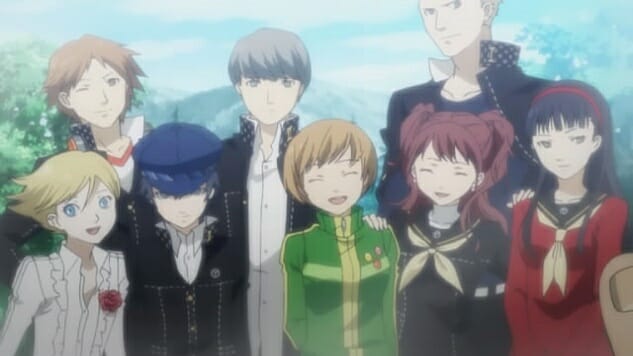
Games are great entertainment, but every so often they make me want to be a better person. When games thoughtfully handle issues like bullying, or throw off gender expectations, they can be genuinely inspiring. For me, an entire franchise does this with consistency: Persona, with its emphasis on fighting against aspects of your own psyche, lends itself nicely to self-reflection.
Take Persona 4. In the animated series based on the game, there is a brief section that takes place in the same location as Persona 3 (Persona 3 and 4 share a timeline). One of the characters, Chie Satonaka, encounters someone getting bulled in a back alley and steps up to intervene—and in the series, the main protagonist witnesses this as well, and even has the police on speed dial should the situation escalate even further. This is in contrast to the villain Tohru Adachi, who—at least in one route—ends up manipulating and blackmailing the protagonist to keep his own crimes hidden. In Persona 4, the heroes are more like people we know in our everyday lives: it’s all about perception, and what plays into those perceptions, and so one villain is a well-meaning councilman and a bigger villain is a police officer who deceives everyone around him. Take the power of the Persona away, take the Velvet Room and Igor and the mysterious attendants away, and we get a tale that is all too similar to a murder mystery that could happen in our everyday lives, in our towns, a story more similar to Stephen King’s less supernatural stories than J.K Rowling.
Persona 3 can also teach us, but on a more epic scale; instead of solving kidnapping cases and murders in a countryside town, Persona 3 takes place in a city area where Apathy Syndrome has already taken hold. Throughout the game, you see non-player-characters become more and more despairing, some become nonresponsive. In the film versions of Persona 3 the opening scene of the first film involves a boy jumping in front of a train. Bullying rears its head again, as party member Fuuka is bullied relentlessly by a more popular girl. This is a story about despair and desperation, not of a few people but of humanity as a whole crying out for someone—something—to stop its collective pain.
Interestingly, even in this game, where the storyline is more about humanity as a whole and what can be done to fight against a collective desire for an end, there is always time to get to know the people around you. The protagonist fights with people he probably would have not easily encountered if left to his own devices. Characters from different social classes and backgrounds are represented. And you can help more people than even that: the game rewards you for talking to people and finding out more about them, helping them with resolution and hope when you can. And while bullying is a gravely important issue in Japan (where these games are made and set), due to the suicides that can be attributed to it, online and in-person bullying is a problem in the United States as well. We have suicides that can be attributed to harassment and bullying; despair knows no cultural boundary. But what Persona 3 and Persona 4 help illustrate is that, while despair and hatred exist in this world, we all have the ability and responsibility to do what we can to fight them, whether it shows itself through bullying or through depression. And short of gaining supernatural powers and having an array of spirits on our side, the Persona games tell us to speak to each other and learn more about each other. Fight despair by listening to people around you.
This is reiterated in Persona 4, which deals with the gulf between what others think of a character and that character’s own self-image. What strikes me is the attitude it seems to take regarding gender expectations—in Persona 4, we have a character who loves kung fu and wants to be a police officer someday (Chie Satonaka), and we have a character who dresses ambiguously in order to be taken seriously as a detective (Naoto Shirogane). On the flip side of that, we have a guy who looks like a biker gang leader but who loves making little knitted/embroidered dolls and other cute things (Kanji Tatsumi). They like what they like, and while others may think “oh, they’re gay” or “oh, they’re not feminine or attractive at all,” the storylines for each of the character links show them acknowledging their strengths and their neuroses and working with them. Hiding an aspect of their own selves only served to give fear power over them, and this translates well to the real world too. While we have to make our way in this world alongside other people, if we hide away aspects of ourselves because of what others may or may not think, eventually fear becomes more and more powerful.
This aspect is what I love most about the Persona series. While these games are meant to be pieces of entertainment that incorporate various mythic story beats, like in any great narrative or grand myth, there are lessons to uncover. These lessons can be to recognize your fears so those fears do not rule you, or to fight against despair, or even simply to try and do what you can to make your corner of the world a little friendlier, a little kinder. To take a note from the animation end title card, the power of the Persona series is that the “bonds between people is the true power”. The rest is up to you.
Katriel Paige is a writer, lecturer, and aspiring game maker. They love learning languages, learning more about folklore, and figuring out which coffee is the best.